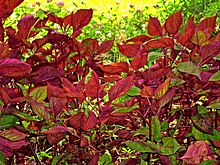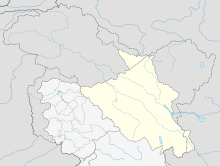들깨
Perilla| 들깨 | |
|---|---|
 | |
| 들깨 | |
| 과학적 분류 | |
| 왕국: | 플랜태 |
| Clade: | 기관지 식물 |
| Clade: | 혈관배양액 |
| Clade: | 유디코트 |
| Clade: | 별자리 |
| 주문: | 라미알레스 |
| 패밀리: | 라미아과 |
| 서브패밀리: | 네페토이데아과 |
| 부족: | 엘솔쯔아과 |
| 속: | 들깨 l. |
들깨는 아시아 주요 작물종 들깨와 민트과에 속하는 자연계 야생종 들깨로 이루어진 속이다.이 속은 아시아의 여러 다른 허브, 씨앗, 야채 작물을 포함하고 있는데, 여기에는 P. frutescens var. crispa(시소)[1]가 포함된다.들깨속은 또한 모든 품종에 [2][3]적용되는 흔한 이름("들깨")이다.들깨의 품종은 교잡이며,[1] 자연히 종내 교배가 일어난다.몇몇 변종들은 [4]침습적인 것으로 여겨진다.
분류군과 동의어
들깨의 분류는 식물학자들이 두 개의 다른 종이나 [1][5]변종으로 구별하는데 어려움을 겪었기 때문에 혼란스럽다.몇 십 년 전까지만 해도, P. frutescens var. crispa는 P. frutescens와 구별되는 그 자체로 하나의 종으로 간주되었지만, 이러한 종류는 쉽게 [6]교잡한다는 것이 잘 입증되었다.두 문화권을 다른 종으로 나눈 초기 예는 1884년 마쓰무라의 명명법 책에서 발견되었는데, 여기서 P. arguta Bent라는 동의어는 P. frutescens [7][8][9][10]var. crispa에 적용되었고, P. ocymoides L.는 P. frutescens에 적용되었다.P. ocymoides 또는 P. ocimoides라는 종명은 역사적으로 특히 [a][6]일본인에 의해 P. frutescens var. crispa를 나타내기 위해 사용되어 왔기 때문에 어느 문화유산의 교환 가능한 동의어로 여겨져서는 안 된다.최근의 유전자 연구는 두 개의 작물을 하나의 [11]종으로 통합한다는 분류학자들의 주장을 뒷받침하면서, 이 문화들이 공통적인 유전자 풀이라는 것을 확인시켜준다.
기존 들깨 종:
- P. frutescens – 한국의 들깨 또는 들깨라고도 불린다; 잎은 kkaennip이라고 불린다.
설명이 불충분하고 하바륨 표본이 알려지지 않은 들깨는 다음과 같다.
- 카발리에이 H.Lev.
- 이형동물 카리에르
- 세토이엔시스 지혼다
과거의 유산과 그에 따른 분류의 재분류는 [14][5]명명법의 혼란을 가져왔다.붉은색 또는 보라색 잎이 있는 P. frutescens [5]var. crispa는 P. nankinensis로 불렸고, 이 라벨은 19세기 내내 서양에서 관상용 식재로 사용되었습니다.녹색 잎이든 붉은 잎이든, 독특한 P. frutescens var. crispa 향을 특징짓는 페리알데히드 인자는 개체 또는 개체군에 존재하거나 존재하지 않을 수 있으며, 이는 겉모습만으로는 구별되지 않는다.화학 연구는 이 속들이 함유된 에센셜 오일에 따라 다른 화학 유형으로 분류합니다.일본 고유의 3종의 야생종이 재배된 P. frutescens var.[11] crispa와 유전적으로 구별되는 것으로 알려져 있지만, 일부 참고 문헌에서는 예를 들어 P. frutescens var.를 취급하고 있다. 히르텔라(Hirtella)는 P. frutescens var. crispa와 [10]같은 종이다.
이전에 여기에 배치됨
- P. 엘라타 D.돈 = 엘솔치아 블란다 (벤트) 벤트.[15]
- 프릭코사 D.돈 = 엘솔치아 프리티코사 (D. Don) 레더[15][16]
- P. lanceolata Benth = Mosla scabra (Thunb.) C.Y.Wu & H.W.리
- P. 렙토스타키아 D.돈 = 엘솔치아 스타키오데스 (링크) 라이자다 & H.O.색세나[15][17]
- P. 마라트로스마 스프렝= 아가스타체 푸에니큘럼(Pursh) 쿤체
- P. 난키넨시스 웬더.= 플렉트란투스 스쿠텔라리오데스 (L.) R.Br.
- P. 폴리스타키아 D.돈 = 엘솔치아 섬모(Thunb) 아휴.[15]
사용하다
요리 용도
들깨 품종은 주로 한국, 일본, 태국,[18] 베트남에서 재배되고 소비된다.P. 프루텐스 잎, 씨앗, 씨앗 기름은 한국 요리에 널리 사용되고, P. 프루텐스 바. 크리스파 잎, 씨앗, 새싹은 일본과 베트남 [19]요리에 사용된다.
허브주의
들깨는 한의학의 50가지 기본 허브 중 하나입니다.그것은 "지수"라고 불리며, 바람, 팽창, 위, 폐의 문제를 분산시키는데 사용된다.그것은 때때로 습기를 없애고 기를 조화시키기 위해 투화샹이나 광화샹과 짝을 이룬다.
메모들
- ^ 예: Heibonsha 1964 Encyclopedia에서 볼 수 있지만 속명은 mispett입니다.
레퍼런스
- ^ a b c Nitta, Miyuki; Lee, Ju Kyong; Ohnishi, Ohmi (2003). "AsianPerilla crops and their weedy forms: Their cultivation, utilization and genetic relationships". Economic Botany. 57 (2): 245–253. doi:10.1663/0013-0001(2003)057[0245:APCATW]2.0.CO;2. ISSN 0013-0001.
- ^ Vaughan, John; Geissler, Catherine (2009). The New Oxford Book of Food Plants (2nd ed.). Oxford: Oxford University Press. p. 340. ISBN 9780199549467.
- ^ Staples, George W.; Kristiansen, Michael S. (1999). Ethnic Culinary Herbs: A Guide to Identification and Cultivation in Hawaiʻi. Honolulu: University of Hawaiʻi Press. p. 82. ISBN 9780824820947.
- ^ "Beefsteak Plant (Perilla frustescens)". National Park Service. U. S. Department of the Interior. 11 November 2010. Retrieved 4 December 2016.
- ^ a b c Yu, He-ci; Kosuna, Kenichi; Haga, Megumi, eds. (1997). Perilla: The Genus Perilla. London: CRC Press. pp. 1–3. ISBN 9789057021718.
- ^ a b Satake, Yoshisuke; Nishi, Sadao; Motoyama, Tekishū, eds. (1969) [1968]. "shiso" しそ. Sekai dai-hyakka jiten 世界大百科事典 [Heibonsha World Encyclopedia]. Vol. 10. Tōkyō: Heibonsha. pp. 246–207.
- ^ Matsumura, Jinzō (1884). Nippon shokubutsumeii 日本植物名彙 [Nomenclature of Japanese plants in Latin, Japanese and Chinese]. Tōkyō: Z.P. Maruya. pp. 136.
- ^ Roecklein, John C.; Leung, PingSun, eds. (1987). A Profile of Economic Plants. New Brunswick, U.S.A: Transaction Publishers. p. 349. ISBN 9780887381676.
- ^ Kays, S. J. (2011). Cultivated Vegetables of the World:: A Multilingual Onomasticon. Wageningen: Wageningen Academic Publishers. pp. 180–181, 677–678. ISBN 9789086861644.
- ^ a b Blaschek, Wolfgang; Hänsel, Rudolf; Keller, Konstantin; Reichling, Jürgen; Rimpler, Horst; Schneider, Georg, eds. (1998). Hagers Handbuch der Pharmazeutischen Praxis (in German) (3 ed.). Berlin: Gabler Wissenschaftsverlage. pp. 328–. ISBN 9783540616191.
- ^ a b Ito, Michiho (2008). "Studies on Perilla Relating to Its Essential Oil and Taxonomy". In Matsumoto, Takumi (ed.). Phytochemistry Research Progress. New York: Nova Biomedical Books. pp. 13–30. ISBN 9781604562323.
- ^ Mendelson, Charlotte (29 Jul 2017). "The Garden's Tiny Culinary Transformations". The New Yorker. Retrieved 18 Nov 2017.
- ^ Seidemann, Johannes (2005). World Spice Plants: Economic Usage, Botany, Taxonomy. Berlin: Springer. p. 278. ISBN 9783540222798.
- ^ Zeevaart, Jan A. D. (1969). "Perilla". In Evans, L. T. (ed.). The Induction of Flowering: Some Case Histories. Ithaca, NY: Cornell University Press. pp. 116–155. ISBN 9780333101537.
- ^ a b c d Bentham, George (1836). Labiatarum Genera et Species. London: James Ridgway and Sons. p. 166.
- ^ Wiersema, John H.; León, Blanca (1999). World Economic Plants: A Standard Reference. CRC Press. ISBN 9780849321191.
- ^ Pangtey, Y. P. S.; Rawal, R. S. (1994). High altitudes of the Himalaya: Biodiversity, ecology & environment. Nainital, India: Gyanodaya Prakashan. p. 338.
- ^ Grbic, Nikolina; Pinker, Ina; Paschko, Kerstin; Böhme, Michael (18–21 September 2016). "The Nutritional Treasure of Leafy Vegetables-Perilla frutescens" (PDF). In Freyer, Bernhard; Tielkes, Eric (eds.). Solidarity in a competing world - fair use of resources. Tropentag 2016 Wien: International Research on Food Security, Natural Resource Management and Rural Development. Göttingen, Germany: Cuvillier. p. 105. ISBN 978-3-9801686-7-0. Retrieved 5 May 2017.
- ^ Brenner, David M. (1993). "Perilla: Botany, Uses and Genetic Resources". In J., Janick; Simon, J. E. (eds.). New crops. New York: John Wiley & Sons. pp. 322–328. ISBN 978-0-471-59374-4.




